"The greatest danger in times of turbulence is not the turbulence; it is to act with yesterday's logic."

The Trillion-Dollar Mirage
The metaverse is dead; long live spatial computing. As tech giants scramble to rebrand their augmented and virtual reality ambitions, a dangerous delusion has taken root in Silicon Valley's fertile soil. The industry, drunk on its own marketing wine, has convinced itself—and is trying to convince us—that we're on the verge of digitally replicating human spatial intelligence. This fundamental misconception threatens to derail not just billions in investment, but decades of potential progress in human-computer interaction.
The breathless headlines following Apple's Vision Pro announcement and Meta's latest Quest offering suggest we're entering an era where digital and physical space will seamlessly merge, guided by interfaces as natural as human thought itself. It's a seductive narrative, one that plays well in keynote presentations and venture capital pitches. It's also dangerously wrong, built on a fundamental misunderstanding of both human cognition and computational capability.

The truth is far more complex and, frankly, more interesting than the industry's simplified marketing narrative. Spatial computing and human spatial intelligence are fundamentally different systems that happen to operate in the same domain. One is a digital system built on precise measurements, algorithmic processing, and binary certainty; the other is a biological system evolved for survival, built on approximations, heuristics, and "good enough" solutions. Treating them as analogous systems isn't just intellectually dishonest—it's actively harmful to the development of genuinely useful spatial computing technologies.
Consider how the human brain processes spatial information. Our spatial intelligence evolved over millions of years, optimized not for precision but for survival. We excel at quick approximations, pattern recognition, and adaptive problem-solving. Our spatial processing is deeply integrated with our emotional systems, memory, and social cognition. We can navigate complex environments with incomplete information, recognize objects from unusual angles, and adapt to new spatial challenges with remarkable flexibility. This biological system, honed by evolution, operates in ways fundamentally different from any digital system we've created.

Yet the tech industry persists in marketing spatial computing as if it were a digital replica of human spatial intelligence. Major tech companies parade their latest devices as if they've somehow captured lightning in a digital bottle, promising interfaces so natural they'll fade into invisibility. Apple's Vision Pro marketing speaks of "infinite canvas" and "spatial reality," while Meta's Zuckerberg envisions a world where digital and physical merge seamlessly. These aren't just marketing exaggerations—they represent a fundamental misunderstanding that threatens to derail the entire field.
The Top Articles of the Week
100% Humanly Curated Collection of Curious Content
The technical reality is far more sobering than the marketing hype suggests. Even the most advanced spatial computing systems struggle with basic challenges that human spatial intelligence handles effortlessly. A child can instantly understand how to navigate around a newly placed obstacle; our best systems require extensive mapping and continuous sensor input to achieve the same result. Human spatial intelligence seamlessly integrates with our social understanding—we instinctively maintain appropriate distances in conversations, adjust our movements based on social context, and understand spatial relationships in group dynamics. Current spatial computing systems, by contrast, can barely distinguish between intentional gestures and casual movements.
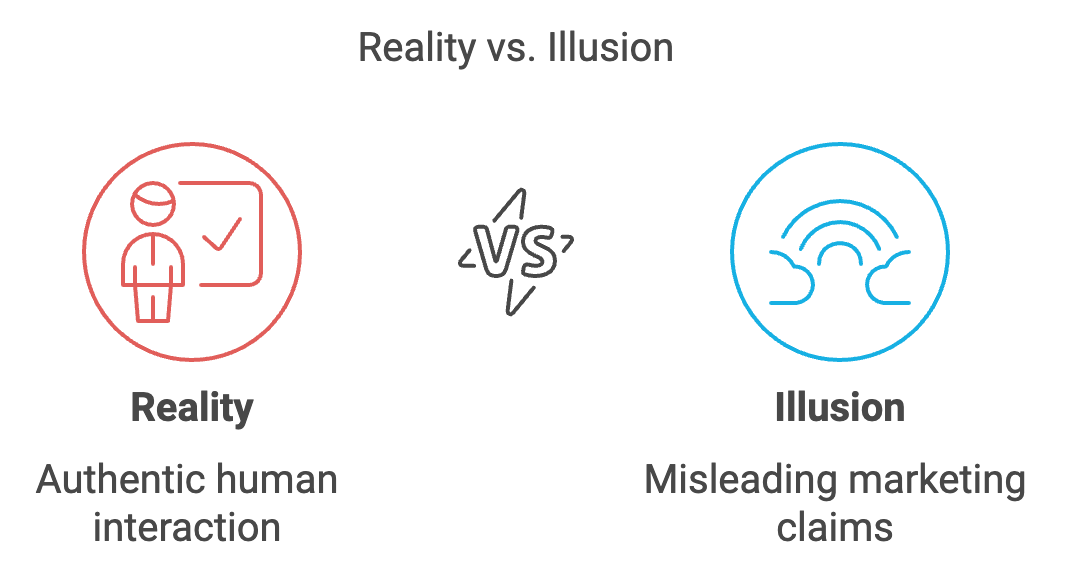
This disconnect between human spatial intelligence and computational spatial processing manifests in countless ways. Consider the simple act of reaching for a cup. Humans perform this action with fluid grace, automatically adjusting for changing conditions, obstacles, and even the expected weight and fragility of the object. Our spatial processing systems handle all this without conscious thought, integrating visual information, proprioception, and learned experience. Current spatial computing systems, despite their sophisticated sensors and algorithms, still struggle to reliably track and predict such movements, let alone understand their context and intent.
The industry's response to these limitations has been to double down on the fantasy, pouring billions into developing ever more complex systems that attempt to replicate human spatial cognition. This approach is fundamentally flawed. It's akin to the early aviation pioneers who insisted on building machines with flapping wings, believing that artificial flight must mimic bird flight. Just as aviation only truly advanced when engineers embraced the differences between artificial and biological flight, spatial computing will only reach its potential when we stop trying to replicate human spatial intelligence and start developing systems that complement it.
The economic implications of this misguided approach are staggering. The spatial computing market is projected to reach over a trillion dollars by 2035, with hundreds of billions being invested in research and development. Much of this investment is being directed toward solving the wrong problems, chasing the chimera of human-like spatial processing instead of developing systems that leverage the unique capabilities of digital computation.
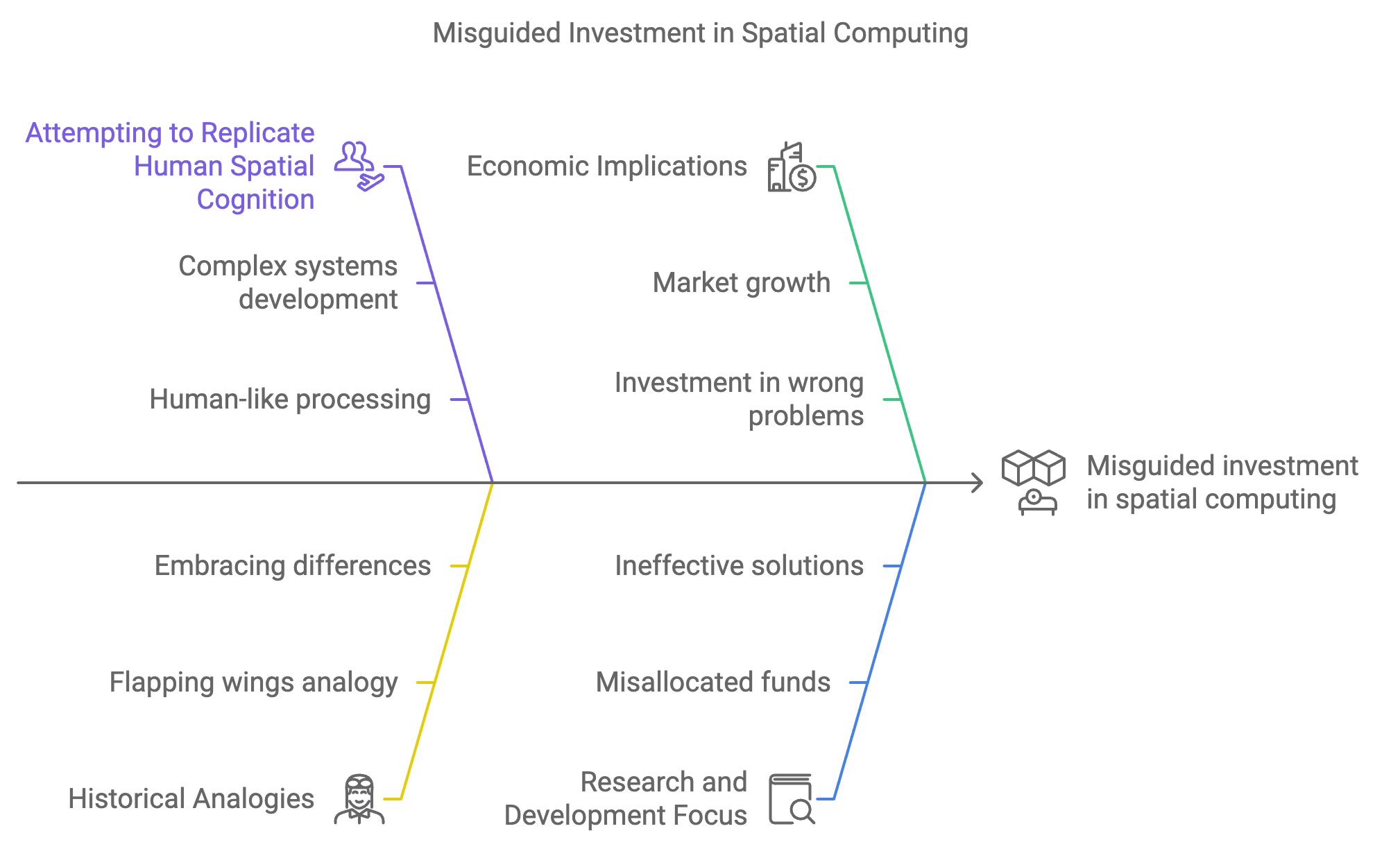
Consider the enterprise applications where spatial computing has shown genuine promise. The most successful implementations don't try to replicate human spatial reasoning—they augment it with capabilities humans don't possess. In manufacturing, spatial computing systems excel at maintaining precise measurements and tolerances, tracking complex assemblies, and ensuring perfect repeatability. In surgical applications, they provide superhuman precision and stability, while leaving the nuanced decisions to human judgment. These successes come from embracing the differences between human and computer spatial processing, not trying to eliminate them.
The path forward requires a fundamental reset in how we think about spatial computing. Instead of trying to create digital versions of human spatial intelligence, we need to focus on developing systems that genuinely complement human capabilities. This means embracing the unique strengths of computational spatial processing—precision, tirelessness, perfect memory—while acknowledging its limitations in areas where human spatial intelligence excels, such as contextual understanding and adaptive problem-solving.
This shift in thinking has profound implications for interface design. Rather than pursuing the myth of "natural" interfaces that attempt to mimic human spatial interaction, we should be developing new interaction paradigms that leverage the strengths of both human and computer systems. This might mean abandoning the current obsession with gesture control in favor of more structured input methods that provide better precision and reliability. It might mean rethinking how we present spatial information, moving away from attempts to create perfect visual illusions and toward interfaces that better support human spatial understanding.
A Wise Investment of Your Time
List of YouTube videos that captured my undivided attention.
The stakes extend far beyond the tech industry. Spatial computing has the potential to transform how we work, learn, and interact with our environment. But realizing this potential requires moving past the current paradigm of digital mimicry. We need systems that enhance human spatial capabilities rather than trying to replicate them, that complement human spatial intelligence rather than competing with it.
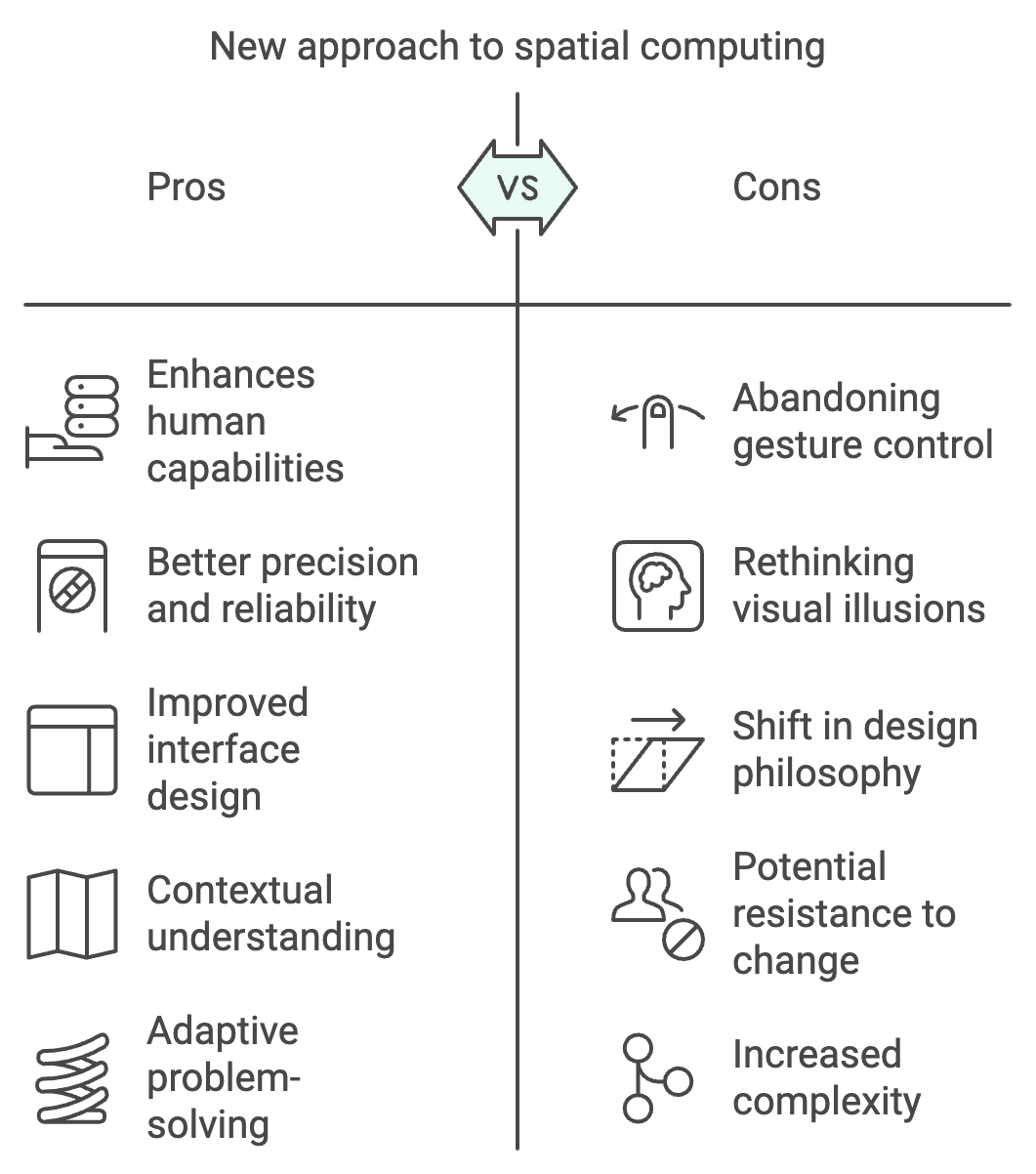
The societal implications of getting this wrong are profound. As spatial computing becomes more prevalent, the way these systems interact with human spatial cognition will increasingly shape how we perceive and interact with our world. If we continue down the current path, we risk creating a generation of systems that force humans to adapt to their limitations rather than truly enhancing human capabilities.
The security and privacy implications are equally concerning. Current approaches to spatial computing, in their attempt to replicate human spatial understanding, require vast amounts of environmental and behavioral data. This creates unprecedented surveillance capabilities and privacy risks. A more thoughtful approach, one that respects the differences between human and computer spatial processing, might lead to systems that require less invasive data collection while providing better functionality.
The time for this fundamental reset is now, before the industry becomes too invested in its current misguided approach. The longer we persist in the fantasy of digitally replicating human spatial intelligence, the more resources we waste, and the further we get from developing truly transformative spatial computing systems.
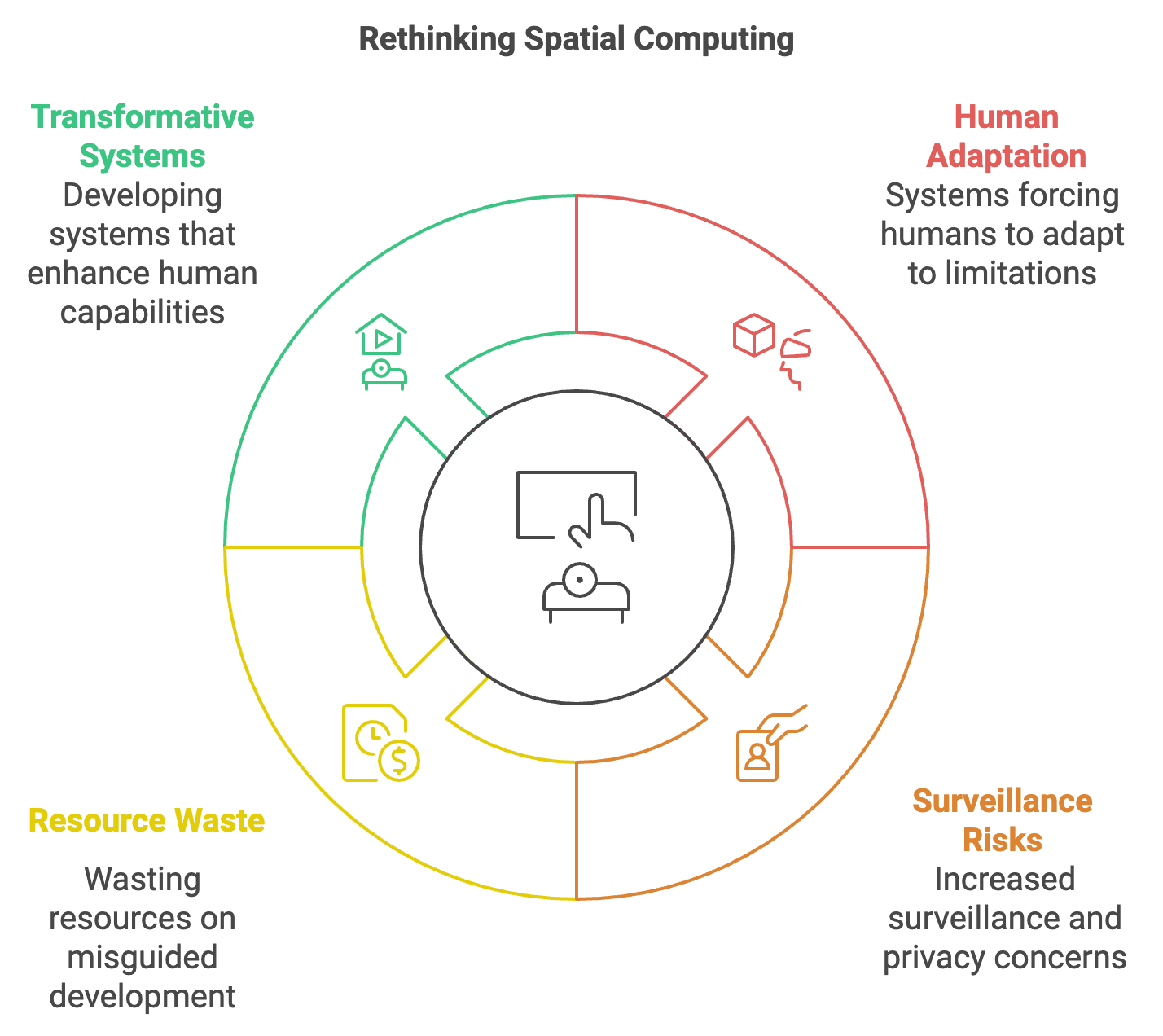
This isn't just about technology—it's about how we understand and enhance human capabilities. The real promise of spatial computing lies not in creating digital versions of human spatial intelligence, but in developing systems that truly complement and enhance human spatial capabilities. This requires moving past the marketing hype and engaging with the real challenges and opportunities of spatial computing.
The future of human-computer interaction depends not on how well we can make computers think like humans, but on how effectively we can create systems that complement and enhance human capabilities while embracing their fundamental differences. It's time to abandon the delusion of digital spatial intelligence and start building the future of spatial computing on a foundation of reality rather than marketing fantasy.
The sooner we confront this truth, the sooner we can begin developing spatial computing systems that deliver on their true promise: not replacing human spatial intelligence, but enhancing it in ways that genuinely advance human capability. The future depends on getting this right, and the clock is ticking.


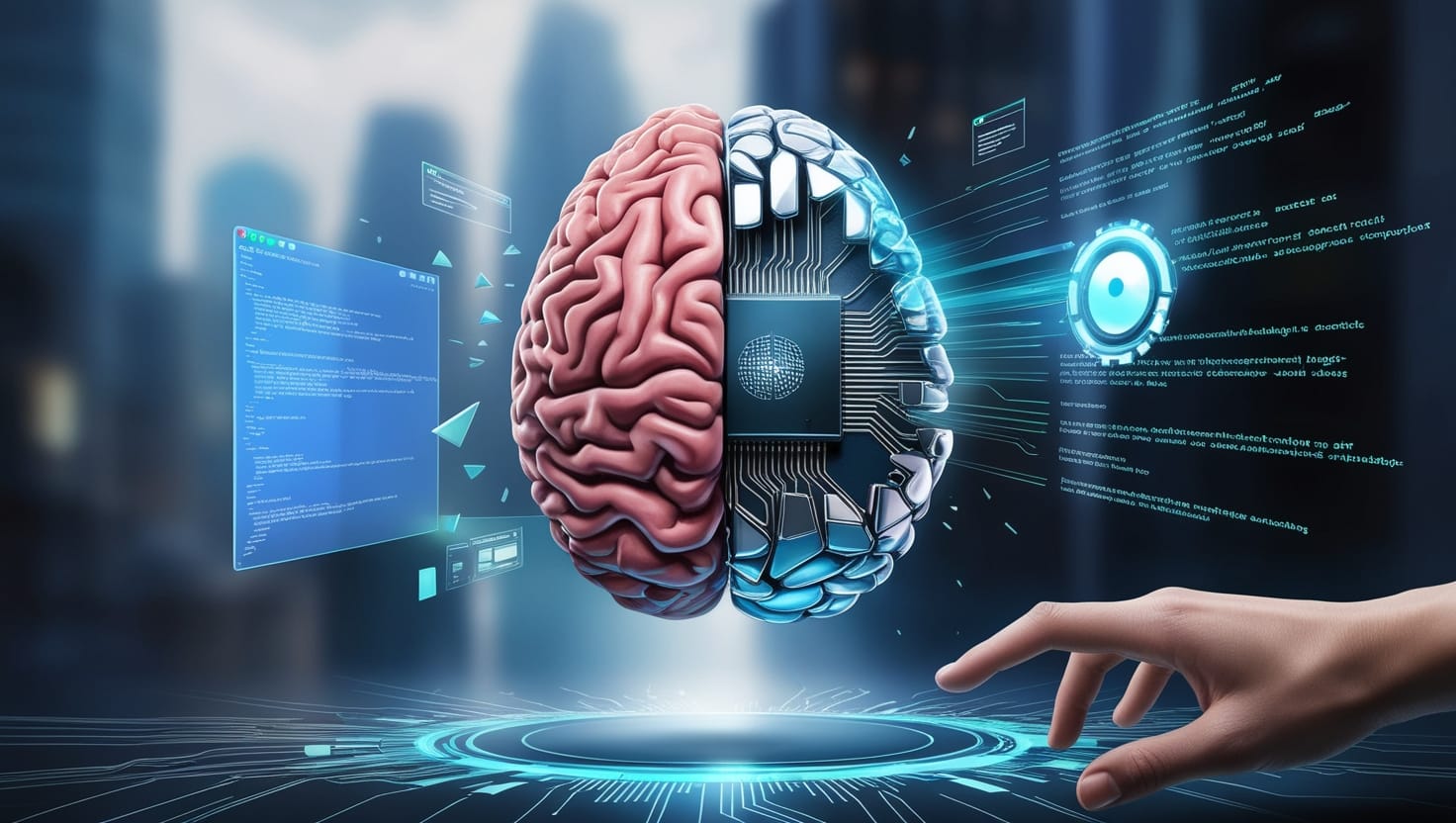

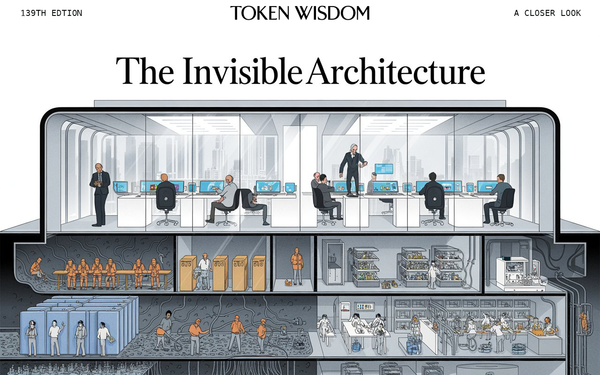




Member discussion